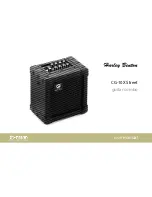
17
The JC 1+ Output Stage
The JC 1+ output stage includes six ultra-premium quality 33,000uF Nichicon “Gold Tune” electrolytic
filter capacitors., These rare parts are chosen for their low Equivalent Series Resistance (ESR), dielectric
absorption and resistance to high temperature. In addition, these filter capacitors are bypassed with smaller
polypropylene capacitors to reduce AC ripple in the DC supply and to further eliminate noise and interference
that is generated in AC power lines, from computers and other appliances in the home.
Relay-Bypassed Soft Start Circuit
When the JC 1+ is turned on, a significant amount of current is required to charge the enormous power
supply capacitors. A sudden in-rush of current stresses capacitors and shortens the product’s life. To prevent
this the JC 1+ employs an NTC (negative temperature coefficient) thermistor to slow down and suppress the
in-rush current. A secondary benefit is that it also prevents tripping of a household circuit breaker or power
strip. In a few seconds, as it heats up to its operating temperature the thermistor drops to near zero ohms of
resistance. However, the JC 1+ goes one step further with this circuit. After the thermistor has done its job of
suppressing the in-rush current a heavy-duty relay with gold contacts activates to jump across the thermistor
to bypass it completely. This extra measure ensures that the thermistor will not restrict any current
whatsoever when the JC 1+ is in full operation.
Complementary Differential Configuration
Each stage (there are three) of amplification employs transistors that require positive DC power and
complementary transistors that require negative DC power that is a mirror image of the positive DC power.
Thus, half of the transistors amplify the positive half of the musical waveform while the other half of the
transistors amplify the negative half. This complementary topology is inherently linear, which minimizes
distortion and improves sonic accuracy.
The Input Stage
The function of the JC 1+’s input stage is voltage gain. It uses matched pairs of N and P channel discrete
JFETs (Junction Field Effect Transistors) arranged in a differential configuration. JFETs are ideal for the input
stage because their inherently high impedance makes them less affected by the impedance of the connected
source components. Ordinary bi-polar transistors are low impedance devices and more susceptible to the
higher impedance of source components. The Differential configuration also provides superior noise
reduction. These precision matched input JFETs are cascaded to produce the current necessary to drive the
MOSFET drivers in the following stage.
The Driver Stage
The driver stage provides further voltage gain for which we employ a complementary matched pair of
MOSFETs (Metallic Oxide Field Effect Transistors) selected for their vacuum tube-like sonic qualities.
MOSFETs tend to generate less odd-order higher harmonic distortion than bipolar transistors. This is
important because odd-order distortion sounds unnatural and fatiguing to the human ear because the
harmonics are dissonant. Even-order distortion is less offensive because it is primarily consonant. The JC 1+
employs a driver stage in a new cascode configuration which improves linearity and reduces distortion. This
sophisticated MOSFET driver stage prevents the harshness and brittle sound so often found in other solid
state amplifiers.
.
The Output Stage
An amplifier’s sonic characteristics are established by its input and driver voltage gain stages. The sole job
of its output stage is to deliver current from its power supply to the speakers. In the output stage bipolar output
transistors are superior to MOSFETs because of their higher safe operating area (SOA) and inherent
ruggedness. The
JC 1
+ employs 24 high current (15-amp) high voltage bipolar transistors to insure long-term
reliability, even with continuous high-power operation and challenging speaker loads. The lightning-fast (60
MHz) transistors respond instantly to complex demands in the musical signal, virtually eliminating distortions
that occur with “slower” transistors. Slew rate limiting and Transient Intermodulation Distortion (TIM) are simply
not an issue in the JC 1+.
Содержание HALO JC 1+
Страница 1: ...JC 1 Mono Power Amplifier OWNER S GUIDE ...
Страница 6: ...6 ...
Страница 7: ...7 ...
Страница 21: ...21 Chassis Illustration and Dimensions ...
Страница 23: ...23 ...
Страница 24: ...24 Parasound Products Inc 2250 McKinnon Ave San Francisco CA 94124 415 397 7100 www parasound com ...








































